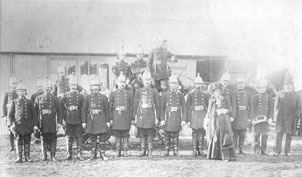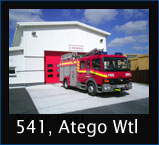Station History - Part 1
The following account was written for the centenary of the founding
of Wadebridge Fire Brigade by Peter Tuthill, a well known local author
and historian. We would like to thank Mr Tuthill for allowing us to
make this excellent history available which was originally published
in the North Cornwall Advertiser, spring 2001.
----------------------------------------------------------------------------------------------------
Being very interested in the history of Wadebridge and also of fire-fighting
my attention was drawn to the item in your December issue. I am writing
with a little more detail relating to the town¹s brigade and some
interesting general facts on the subject
Over a century ago Wadebridge had no fire brigade, in common with many
other towns. If a fire occurred, you called for help from the local
populace, this was sometimes done by the town crier, and they formed
a bucket chain to the nearest source of water - not particularly effective.
Insurance companies formed some of the country¹s first fire brigades,
you paid for insurance and they gave you a pretty metal plaque to attach
to your building. When a fire occurred the brigade would turn out -
only to find YOUR metal plaque was from another company, so they either
stood and watched or returned to their station. Some people therefore
insured with more than one company, what then sometimes ensued were
pitched battles between fire crews as to who would have the honour of
extinguishing the blaze. Excellent entertainment for the bystanders!
Gradually cities and towns formed their own brigades of volunteers.
In some instances the police were also the firemen, in my home town
of Penzance the police were at one time responsible also for manning
the fire engine and ambulance, as well as maintaining the peace.
In the year 1900 the population of Wadebridge was about 2,000 and the
Town Council was only two years old. Quite a number of Cornish towns
had formed their own fire brigades, so Wadebridge felt they should also
follow this lead, particularly as there had recently been a number of
conflagrations in the town. So in September 1900, the Wadebridge Urban
District Council, as it was then known, voted to spend up to £1,000
on forming its own fire brigade.
This was speedily organised, and by early October Captain Grant and
Sub Captain Bate had been appointed with a crew of seven plus the boy
bugler (H. Higman) to alert them all.
Local names featured prominently, such as Lobb, Mathews, Hornabrook,
Bonney, Chidgey in that first crew. However so many offered their services
that a reserve crew was also formed with further local names to the
fore - Nicholls, Harding, George, Knight, Warne, Richards, Lean and
Ward. How many of their descendants can remember their relatives serving
in the Wadebridge Volunteer Fire Brigade?
The council paid for their clothing, but were unable, or unwilling,
to pay for the extra equipment required. They purchased capes, uniforms
and boots for each crew member at just under £3.50 per man and
special uniforms for the captain and his deputy. The council obtained
a horse-drawn steam-powered pump, but the two horses were either lent
or hired to tow the steamer.
Further equipment such as hoses, ladders, hooks etc. was approved on
condition that the brigade obtained a loan for their purchase, provided
they raised the funds themselves to repay the sum within twelve months.
Even more difficult were the funds for establishing the first fire station.
This was in Eddystone Road. It was the premises used for a number of
years by Geoff Searle¹s garage and today by Acorn Antiques, that
were occupied by the brigade from its inception until the end of the
second world war. The town council had applied to the Local Government
Loan Board for some £750 to cover all the expense of setting up
the brigade, but this was rejected. Mid Cornwall Rechabite Society were
to come to the rescue by lending the money on favourable terms over
twelve years, backed by guarantees from two prominent Wadebridge council
members.
The Wadebridge Volunteer Fire Brigade were ready and raring to get into
action whilst awaiting the construction of their brand new station,
and started their training sessions in mid November 1900. Before Christmas
that year they staged drills on the town¹s streets using water
for the first time from hydrants behind the Molesworth Arms and overlooking
the Railway Station, these quickly turned into a spectacle for the town¹s
populace. They were not as smooth a demonstration as had been hoped
as the hydrants became blocked with stones, resulting in reduced water
pressure or in one instance NO water at all, to the acute embarrassment
of the volunteers. However, this was better than discovering the problem
at an actual fire. The district council, as the responsible authority,
were called in to sort the matter out. Mains water had only been introduced
to Wadebridge two years earlier via the newly-opened reservoir on top
of the hill at Coronation Park.
The Fair Plot, known today as The Platt was the scene shortly afterwards
for an official demonstration of the Brigade¹s skills, right in
front of the Town Hall, when jets of water reached greater heights than
that building¹s roof, drawing forth enthusiastic applause from
the watching masses. Water was not the only problem for the new brigade
as members left and were replaced in quick succession, reflecting teething
problems in setting up a completely new organisation.
By the new year, the fire station was complete and ready for occupation,
but on being handed the keys to the premises it was discovered they
didn¹t fit the doors. Fortunately this was quickly rectified and
the Brigade faced 1901 with enthusiasm, secretly hoping that their new-found
skills would soon be put to the test. Finally, at eight o¹clock
on the bright morning of April 11th the bugle call sounded in earnest
for the volunteers first real test - the locomotive shed of the London
& South Western Railway Company was alight. Clouds of grey smoke
swept across the town as the crew rushed to the fire station and the
crowds to the railway station to watch the drama unfold. In twelve minutes
the men had laid some 360 feet of hosepipe and were playing a jet of
water on to the roof of the shed, which had been set alight by the heat
from the iron chimney projecting through it. By nine o¹clock, in
a demonstration of great efficiency, the fire had been extinguished,
the hoses had been rolled up, the steamer returned to barracks, the
horses back to more mundane duties, the volunteers to everyday work
and Wadebridge citizens returned to the humdrum of weekday routine.
The town¹s Fire Brigade had performed well on its Baptism of Fire.
This is less than nine month¹s history of the Brigade, but should
it be of interest, there are many more stories to be told, both sad
and amusing, to fill the remainder of a century of service at Wadebridge.
Peter Tuthill
|

This fine body of men is the Wadebridge Fire Brigade circa 1907, and
is of both shifts. The lady is thought to be a Mrs Emily Glencross and
Harry Woolcock the second bugler is probably front row, second on the
right. First and Second Bugler possibly refers to their shift and not
status. The steam engine was called Emily in honour of Mrs Glencross
whose family doubtless sponsored the brigade.
|






